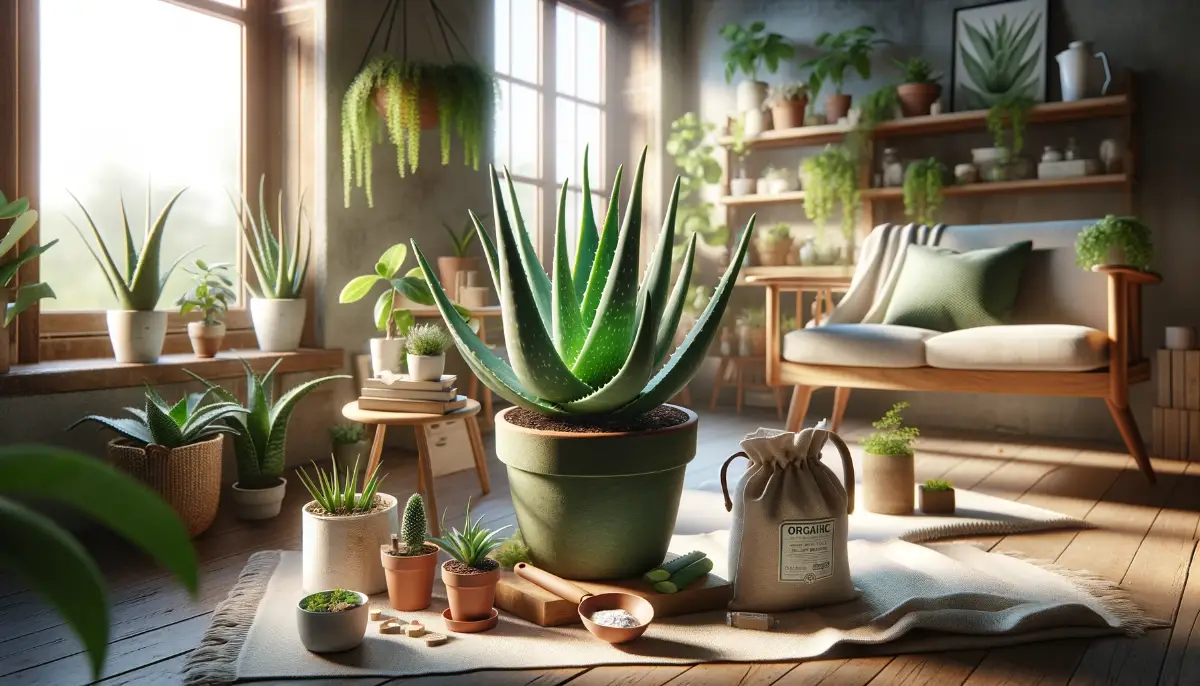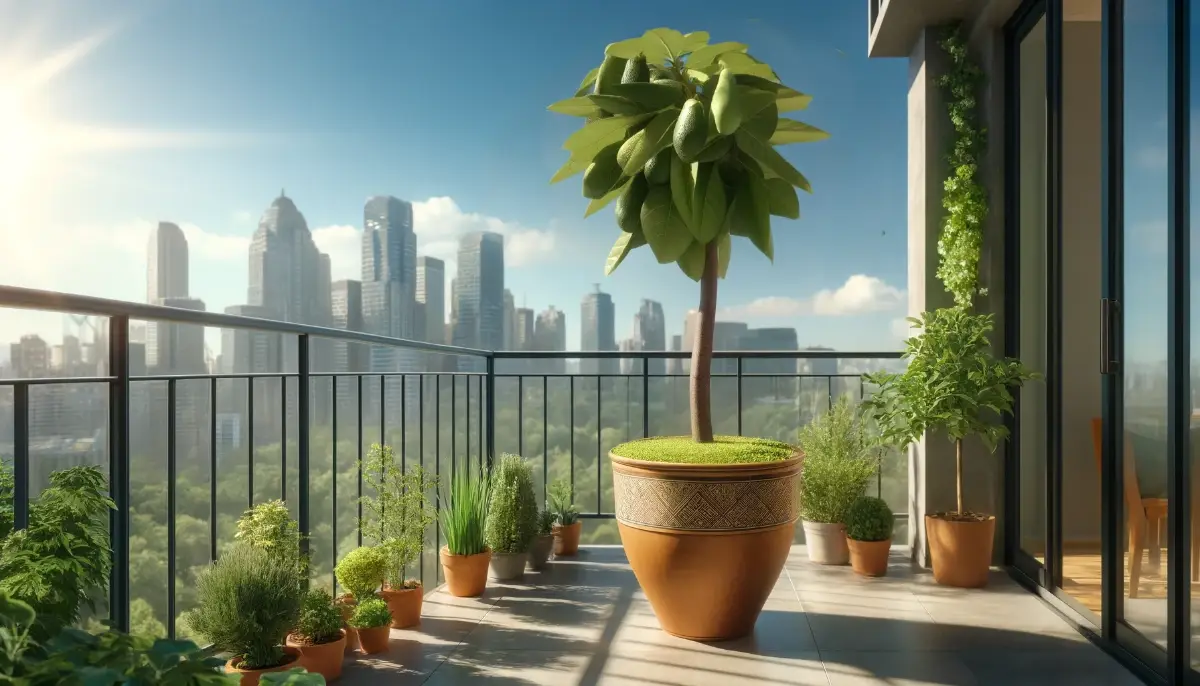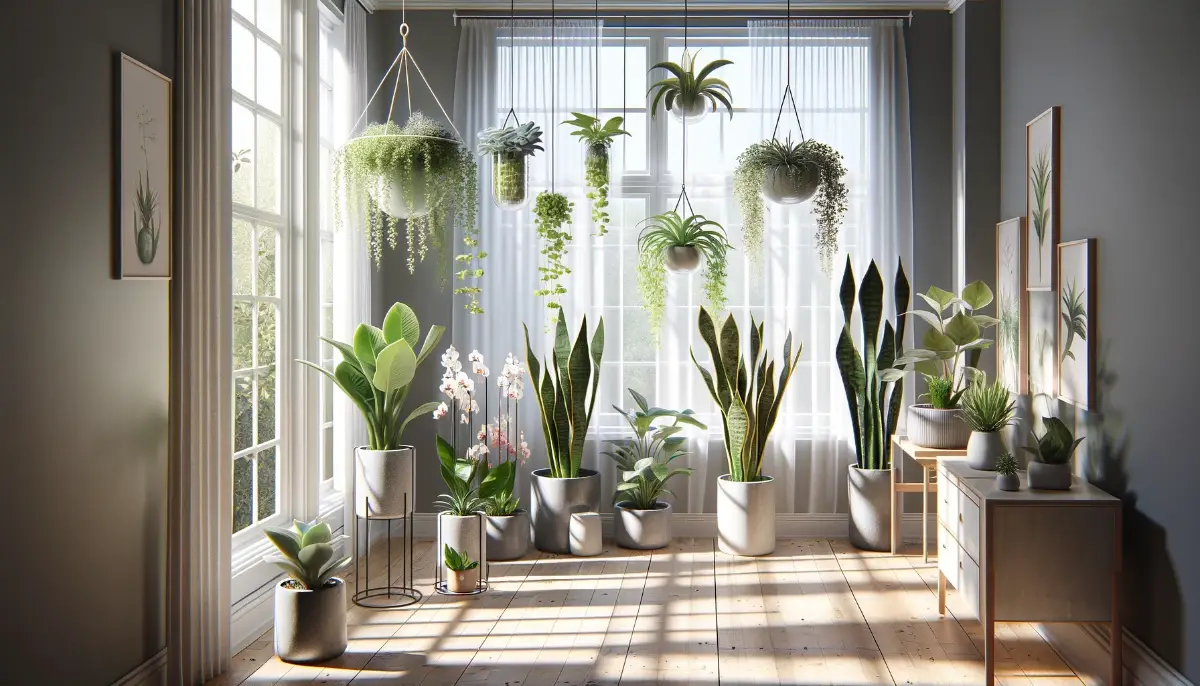Aloe vera is a popular succulent plant known for its medicinal and decorative qualities. Easy to grow and care for, it’s a favorite among houseplant enthusiasts and herbalists alike.
This resilient plant not only beautifies indoor spaces but also offers a plethora of health benefits, from soothing skin irritations to aiding in digestion.
Whether you’re an experienced gardener or a novice looking to add a touch of green to your home, understanding the essentials of aloe vera care will ensure your plants thrive.
- Aloe vera requires specific light and water conditions to thrive.
- Propagation through offsets allows easy multiplication of your aloe vera collection.
- Troubleshooting common aloe vera problems ensures long-term plant health.
Optimal Growing Conditions
Light Requirements
Aloe vera plants thrive in conditions that mimic their natural desert habitat, which means they prefer plenty of light. To ensure your aloe vera is receiving the optimal amount of light, here are a few key tips:
- Amount of Light: Aloe vera requires bright, indirect sunlight to maintain its health and prevent legginess. Positioning your aloe vera in a location that receives at least 6 hours of indirect sunlight daily is ideal.
- Direct vs. Indirect Sunlight: While these plants love light, too much direct sunlight can cause their leaves to burn, especially during hot summer days. A south-facing window covered with a sheer curtain provides a good balance of light, shielding the plant from the harshest rays while letting enough light through.
- Adjusting Light Exposure: If natural light is limited, particularly in winter months or in very cloudy climates, consider using an artificial grow light to supplement. Aloe vera responds well to grow lights, and this can help maintain its vibrant color and growth.
By ensuring your aloe vera receives the right amount of light, you’ll keep your plant healthy and vigorous, enhancing both its aesthetic and therapeutic qualities. Make sure to monitor the plant’s response to its lighting conditions and adjust as needed to prevent any signs of distress like browning or wilting leaves.
Soil and Potting Needs
For aloe vera to thrive, the choice of soil and pot is crucial. Here’s what you need to consider when setting up your plant:
- Well-Draining Soil: Aloe vera plants require well-draining soil to prevent water retention that could lead to root rot. A commercial cacti and succulent potting mix is ideal because it usually contains a blend of coarse sand, perlite, and organic matter, which helps to ensure proper drainage.
- Pot Selection: When choosing a pot for your aloe vera, opt for one with at least one drainage hole. Terra cotta pots are highly recommended because their porous nature allows the soil to dry more evenly and quickly. This can be especially beneficial for preventing overwatering.
- Pot Size and Repotting: Aloe vera plants do well in pots that offer enough space for growth but are not overly large. Start with a pot that is slightly larger than the root ball and consider repotting as the plant grows. Repotting every two to three years can help refresh the soil and provide room for growth.
Ensuring that your aloe vera has the right soil type and pot will significantly affect its health and growth. Regularly check that the soil dries out between waterings and adjust your watering schedule and soil type as needed to keep your plant healthy.
Watering Your Aloe Vera
Proper watering is crucial for the health of your aloe vera. Here’s how to get it right:
- Watering Frequency: Aloe vera plants need to be watered deeply but infrequently. The key is to let the soil dry out completely between waterings. During the growing season (spring and summer), watering every 2-3 weeks is usually sufficient. In the cooler months, reduce the frequency further, watering only once every 4-6 weeks.
- Checking Soil Moisture: Before watering, check the moisture level of the soil. You can do this by sticking your finger about an inch deep into the soil. If it feels dry, it’s time to water. If it’s still moist, wait a few more days before checking again.
- How to Water: When you do water, do so thoroughly until water runs out of the drainage holes of the pot. Allow the pot to drain completely, and never let your aloe vera sit in water as this can lead to root rot.
- Adjusting for Conditions: The amount of water your aloe vera needs can vary based on several factors including pot size, indoor climate, and the plant’s overall health. It’s important to adjust your watering schedule based on these conditions to prevent overwatering or underwatering.
By mastering the watering needs of your aloe vera, you’ll ensure it remains healthy and robust, displaying thick, juicy leaves that are a hallmark of a well-cared-for plant.
Feeding Your Aloe Vera
To maintain a healthy and vibrant aloe vera plant, organic feeding is an excellent approach. Here are some guidelines on how to nourish your aloe vera using organic methods:
- Frequency of Feeding: Aloe vera doesn’t require frequent fertilization. Feeding it once in the spring and again in mid-summer is adequate. This minimal approach helps prevent nutrient overload, which can harm the plant
- Types of Organic Fertilizers: Opt for organic fertilizers that are low in nitrogen and higher in phosphorus and potassium, which support root and cell wall strength. Organic liquid seaweed or fish emulsion are great choices as they provide a gentle dose of nutrients without the risk of chemical burns to the plant.
- Application Method: When applying liquid organic fertilizers, dilute them more than the label recommends for other plants. Aloe vera is sensitive to strong concentrations. Apply the diluted fertilizer directly to the soil, avoiding the leaves to prevent any residue build-up that could block the pores of the plant.
- Consider Homemade Composts: Making your own compost can be a sustainable way to feed your aloe vera. Use compost made from kitchen scraps and yard waste. However, ensure it is well-rotted and free of any large chunks that might impede the drainage of the potting mix.
By using organic methods to feed your aloe vera, you not only support its health but also contribute to a more environmentally friendly gardening practice. This approach ensures that your plant grows strong and healthy, with minimal impact on the environment.
Pruning and Maintenance of Aloe Vera
Regular pruning and maintenance are crucial for keeping your aloe vera healthy and aesthetically pleasing. Here’s how to properly care for your aloe vera through pruning and general maintenance:
- When to Prune: Prune your aloe vera when you notice dead or dying leaves, typically around the base of the plant. This can occur at any time of year but is especially common after winter or a period of low light.
- How to Prune: Use a clean, sharp knife or scissors to cut the leaf at its base, close to the stem. Make sure to cut cleanly without pulling the leaf to avoid damaging the plant. Remove only a few leaves at a time to prevent stressing the plant.
- Maintenance Checks: Regularly inspect your aloe vera for signs of pests or diseases. Common issues include scale, mealybugs, and fungal infections. Early detection is key to effective treatment.
- Cleaning the Leaves: Dust can accumulate on aloe vera leaves, blocking sunlight and reducing the plant’s ability to photosynthesize. Gently wipe the leaves with a damp cloth or sponge to keep them clean and efficient at absorbing light.
- Monitoring Soil and Roots: Occasionally check the soil and root health when you water or prune your plant. Ensure that the soil is not too compacted and that the roots are healthy and not rotting. Over time, you might need to refresh the soil or change the potting mix to ensure optimal growth conditions.
Proper pruning and regular maintenance will help ensure that your aloe vera not only survives but thrives, providing beauty and potential health benefits for years to come.
Propagating Aloe Vera
Propagating aloe vera is a straightforward way to multiply your plants and share them with friends. Here’s a guide on how to successfully propagate aloe vera from offsets, commonly known as pups:
- Identifying and Separating Pups: Aloe vera plants produce pups that can be found growing around the base of the mother plant. These pups should have their own roots. Use a clean, sharp knife or scissors to carefully separate the pup from the mother plant. Make sure each pup has some roots attached.
- Preparing the Pups: After separation, allow the pups to dry out for a few days to form a callous over the cut area. This helps to protect the pup from rot when planted.
- Potting the Pups: Plant the pups in a well-draining succulent or cacti soil mix. Use pots with drainage holes to prevent water retention, which could lead to root rot. Plant them at the same depth they were growing at while attached to the mother plant.
- Caring for Newly Potted Pups: Place the newly potted pups in a bright, indirect light area. Water sparingly at first to prevent rot, allowing the soil to dry out completely between waterings. After a few weeks, once the pups have established, you can gradually increase watering frequency to match that of a mature aloe vera.
By following these steps, you can effectively propagate your aloe vera plants, expanding your collection and sharing the joy of gardening with others.
Troubleshooting Common Issues with Aloe Vera
Even though aloe vera is generally low-maintenance plant, certain problems can arise that may need attention. Here’s how to troubleshoot some common issues:
- Leggy Growth: If your aloe vera is stretching out or becoming leggy, it likely isn’t receiving enough light. Move your plant closer to a south-facing window or consider supplementing with a grow light to provide more direct light .
- Overwatering and Root Rot: Overwatering is a common issue, especially in cooler months. Signs include a mushy base or discolored leaves. Reduce watering and ensure the pot has good drainage. In severe cases, you may need to cut away the rotten parts and repot the healthy top section into fresh, dry soil.
- Underwatering: Aloe vera plants can withstand drought, but prolonged lack of water can lead to dried out, shriveled leaves. If the plant looks deflated, increase your watering frequency slightly, always allowing the soil to dry out between waterings.
- Pests: Aloe vera can attract pests like aphids, scale insects, and mealybugs. These pests usually appear as small bumps or cottony masses on leaves and stems. Treat infestations early with neem oil or insecticidal soap, focusing on the affected areas.
Sunburn: Aloe vera enjoys bright light but can get sunburnt if exposed to direct sunlight for too long. Signs include brown or faded patches on the leaves. If this occurs, move your plant to a location with filtered sunlight or provide some shade during the hottest part of the day.
FAQs About Caring for Aloe Vera at Home
How often should I water my aloe vera plant?
Water your aloe vera every 2-3 weeks, allowing the soil to dry completely between waterings. In winter, reduce the frequency.
What type of soil is best for aloe vera?
Use a well-draining potting mix, ideally formulated for cacti and succulents, to prevent water retention and root rot.
How much light does an aloe vera plant need?
Aloe vera thrives in bright, indirect sunlight. It should receive at least 6 hours of light per day, but direct sunlight should be moderated to avoid leaf burn.
Can I use tap water to water my aloe vera?
It’s better to use filtered or distilled water, as tap water can contain minerals that might build up in the soil and harm the plant over time.
When should I repot my aloe vera plant?
Repot your aloe vera every 2-3 years or when you notice that it has outgrown its current pot, which is evident when roots begin to crowd.
Can aloe vera plants be kept outside?
Aloe vera can be kept outdoors in regions with warm climates (USDA zones 10-12). In colder areas, they should be brought inside or protected during the winter.
How do I propagate aloe vera?
Propagate aloe vera by separating pups from the mother plant. Ensure each pup has some roots, let them dry out for a few days, then plant in well-draining soil.
What are common pests that affect aloe vera plants?
Common pests include aphids, mealybugs, and scale insects. These can be treated with neem oil or insecticidal soap.
How can I make my aloe vera plant flower?
Flowering is rare in indoor conditions but can be encouraged by providing optimal care, particularly by mimicking the natural light and temperature fluctuations it would experience in its native environment.
What should I do if my aloe vera’s leaves become thin and curl?
This is often a sign of underwatering. Increase your watering slightly, making sure the soil dries out completely between sessions.









